Modeling and analysis of heat rejection subsystems for space power systems: steady-state and transient thermal management
IF 6.9
2区 工程技术
Q2 ENERGY & FUELS
引用次数: 0
Abstract
High-power space nuclear power systems are the development direction for future deep space exploration, aiming to provide stable and reliable power to loads in environments lacking solar energy and in complex conditions. However, only a small portion of the heat generated by space nuclear power systems is converted into electric energy through the power conversion system, while most of the heat must be effectively dissipated into outer space to ensure the Heat Rejection Subsystem (HRS) operates within its normal temperature range. Therefore, space power systems require a reliable heat rejection subsystem to dissipate excess heat via radiation. This study develops a detailed mathematical-physical model for the heat rejection subsystem of space power systems, and constructs a transient analysis model based on a heat pipe-fin unit consisting of a single titanium-water heat pipe and radiation fins. Considering the operational characteristics of the space environment, the study designs different steady-state and transient conditions for the space heat rejection subsystem and conducts an analysis of the operational characteristics, providing recommendations for the design of the space nuclear power system’s heat rejection subsystem and factors to consider during transient operation.
空间动力系统散热子系统的建模与分析:稳态与瞬态热管理
大功率空间核动力系统是未来深空探测的发展方向,旨在为缺乏太阳能的环境和复杂条件下的负载提供稳定可靠的电力。然而,空间核动力系统产生的热量只有一小部分通过功率转换系统转化为电能,而大部分热量必须有效地散发到外层空间,以保证散热子系统(heat Rejection Subsystem, HRS)在其正常温度范围内工作。因此,空间动力系统需要一个可靠的散热子系统来通过辐射消散多余的热量。建立了空间动力系统散热分系统的详细数学物理模型,构建了基于单钛水热管和辐射翅片组成的热管-翅片单元的瞬态分析模型。结合空间环境的运行特点,设计了不同稳态和瞬态工况的空间排热分系统,并对其运行特性进行了分析,为空间核动力系统排热分系统的设计和瞬态运行时的考虑因素提供建议。
本文章由计算机程序翻译,如有差异,请以英文原文为准。
求助全文
约1分钟内获得全文
求助全文
来源期刊

Applied Thermal Engineering
工程技术-工程:机械
CiteScore
11.30
自引率
15.60%
发文量
1474
审稿时长
57 days
期刊介绍:
Applied Thermal Engineering disseminates novel research related to the design, development and demonstration of components, devices, equipment, technologies and systems involving thermal processes for the production, storage, utilization and conservation of energy, with a focus on engineering application.
The journal publishes high-quality and high-impact Original Research Articles, Review Articles, Short Communications and Letters to the Editor on cutting-edge innovations in research, and recent advances or issues of interest to the thermal engineering community.
 求助内容:
求助内容: 应助结果提醒方式:
应助结果提醒方式:


